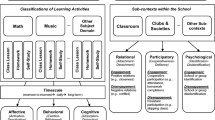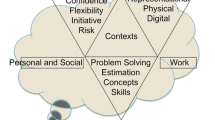Abstract
Equity is an important element of educational discourses pertaining to mathematics and science education. Creativity is an aspect of the classroom that is often ignored due to curricular constraints and the burden of testing. However mathematics offers avenues to infuse the regular curricula with activities that are thought provoking and require creativity and these are accessible to learners of all levels. This article reviews creativity strategies that can be embedded in mathematics curricula to increase classroom equity. These strategies will include the strength of presenting open-ended problems, modeling and encouraging risk taking, discussions and debate of mathematical concepts, concept based learning, divergent thinking strategies during problem solving activities, and incorporating cultural awareness and creativity into curricula and classroom environment. The article will focus both on teacher implementation of these strategies and student outcomes regarding creativity and equity.
Similar content being viewed by others
References
Amabile, T. M. (1996). Creativity in context: Update to “The social psychology of creativity”. Boulder: Westview Press.
Avitia, M. J., & Kaufman, J. C. (2014). Beyond g and c: The relationship of rated creativity to long-term storage and retrieval(glr). Psychology of Aesthetics, Creativity, and the Arts, 8, 293–302.
Baer, J. (2011a). How divergent thinking tests mislead us: Are the Torrance tests still relevant in the 21st century? Psychology of Aesthetics, Creativity, and the Arts, 5, 309–313.
Baer, J. (2011b). Four (more) arguments against the Torrance tests. Psychology of Aesthetics, Creativity, and the Arts, 5, 316–317.
Baer, J., & Kaufman, J. C. (2008). Gender differences in creativity. Journal of Creative Behavior, 42, 75–106.
Baer, J., & Kaufman, J. C. (2012). Being creative inside and outside the classroom. Rotterdam: Sense Publishers.
Beghetto, R., & Sriraman, B. (2017). Creative contradictions in education: Cross disciplinary paradoxes and perspectives. Switzerland: Springer.
Beghetto, R. A. (2013). Killing ideas softly? The promise and perils of creativity in the classroom. Charlotte: IAP Information Age Publishing.
Beghetto, R. A., & Kaufman, J. C. (2007). Toward a broader conception of creativity: A case for mini-c creativity. Psychology of Aesthetics, Creativity, and the Arts, 1, 73–79.
Beghetto, R. A., & Kaufman, J. C. (2009). Intellectual estuaries: Connecting learning and creativity in programs of advanced academics. Journal of Advanced Academics, 20, 296–324.
Beghetto, R. A., Kaufman, J. C., & Baer, J. (2014). Teaching for creativity in the common core classroom. New York: Teachers College Press.
Beghetto, R. A., & Kaufman, J. C. (Eds.). (2010). Nurturing creativity in the classroom. New York: Cambridge University Press.
Beghetto, R. A., & Kaufman, J. C. (Eds.). (2016). Nurturing creativity in the classroom (2nd edn.). New York: Cambridge University Press.
Beghetto, R. A. (in press). Creativity in teaching. In J. C. Kaufman, J. Baer & V. P. Glăveanu (Eds.), Cambridge handbook of creativity across different domains. New York: Cambridge University Press.
Bleske-Rechek, A., & Browne, K. (2014). Trends in GRE scores and graduate enrollments by gender and ethnicity. Intelligence, 46, 25–34.
Blessinger, P., & Watts, L. S. (2006). History and nature of creative learning. In L. S. Watts & P. Blessinger (Eds.), Creative learning in higher education: International perspectives and approaches (pp. 3–13). New York: Routledge.
Boaler, J. (1997). Experiencing School Mathematics. Buckingham: Open University Press.
Costa, P. T., & McCrae, R. R. (1992). NEO PI-R: Professional manual. Odessa: Psychological Assessment Resources.
Cropley, A. J. (2001). Creativity in education & learning: A guide for teachers and educators. London: Stylus.
Csikszentmihalyi, M. (1996). Creativity: Flow and the psychology of discovery and invention. New York: HarperCollins.
DeYoung, C. G. (2014). Openness/intellect: A dimension of personality reflecting cognitive exploration. In M. L. Cooper & R. J. Larsen (Eds.), APA handbook of personality and social psychology: Personality processes and individual differences (Vol. 4, pp. 369–399). Washington, DC: American Psychological Association.
DeYoung, C. G. (2015). Cybernetic big five theory. Journal of Research in Personality, 56, 33–58.
Feist, G. J. (1998). A meta-analysis of personality in scientific and artistic creativity. Personality and Social Psychology Review, 2, 290–309.
Feist, G. J., Reiter-Palmon, R., & Kaufman, J. C. (Eds.). (2017). Cambridge handbook of creativity and personality research. New York: Cambridge University Press.
Gallagher, A. M., & Kaufman, J. C. (Eds.). (2005). Gender differences in mathematics. New York: Cambridge University Press.
Geissler, G. L., Edison, S. W., & Wayland, J. P. (2012). Improving students’critical thinking, creativity, and communication skills. Journal of Instructional Pedagogies, 8, 1–8.
Gocłowska, M. A., Baas, M., Crisp, R. J., & De Dreu, C. K. W. (2014). Whether social schema violations help or hurt creativity depends on need for structure. Personality and Social Psychology Bulletin, 40, 959–971.
Gocłowska, M. A., & Crisp, R. J. (2013). On counter-stereotypes and creative cognition: When interventions for reducing prejudice can boost divergent thinking. Thinking Skills and Creativity, 8, 72–79. doi:10.1016/j.tsc.2012.07.001.
Gocłowska, M. A., Crisp, R. J., & Labuschagne, K. (2013). Can counter-stereotypes boost flexible thinking? Group Processes and Intergroup Relations, 16, 217–231.
Goldin, G. (2004). Problem solving heuristics, affect, and discrete mathematics. International Reviews on Mathematical Education, 36(2), 56–60.
Guilford, J. P. (1950). Creativity. American Psychologist, 5, 444–454.
Guilford, J. P. (1967). The nature of human intelligence. New York: McGraw-Hill.
Hennessey, B., & Amabile, T. (2010). Creativity. Annual Review of Psychology, 61, 569–598.
Ivcevic, Z., & Kaufman, J. C. (2013). The can and cannot do attitude: How self estimates of ability vary across ethnic and socioeconomic groups. Learning and Individual Differences, 27, 144–148.
Karwowski, M., & Kaufman, J. C. (Eds.). (2017). The creative self: How our beliefs, self-efficacy, mindset, and identity impact our creativity. San Diego: Academic Press.
Kaufman, J. C. (2006). Self-reported differences in creativity by gender and ethnicity. Journal of Applied Cognitive Psychology, 20, 1065–1082.
Kaufman, J. C. (2010). Using creativity to reduce ethnic bias in college admissions. Review of General Psychology, 14, 189–203.
Kaufman, J. C. (2015). Why creativity isn’t in IQ tests, why it matters, and why it won’t change anytime soon… .Probably. Journal of Intelligence, 3, 59–72.
Kaufman, J. C. (2016). Creativity 101 (2nd edn.). New York: Springer.
Kaufman, J. C., & Baer, J. (2002). Could Steven Spielberg manage the Yankees?: Creative thinking in different domains. Korean Journal of Thinking and Problem Solving, 12, 5–15.
Kaufman, J. C., & Beghetto, R. A. (2013). In praise of Clark Kent: Creative metacognition and the importance of teaching kids when (not) to be creative. Roeper Review, 35, 155–165.
Kaufman, J. C., Beghetto, R. A., & Watson, C. (2016). Creative metacognition and self-ratings of creative performance: A 4-C perspective. Learning and Individual Differences, 51, 394–399.
Kaufman, J. C., Gentile, C. A., & Baer, J. (2005). Do gifted student writers and creative writing experts rate creativity the same way? Gifted Child Quarterly, 49, 260–265.
Kaufman, J. C., Kaufman, S. B., & Lichtenberger, E. O. (2011). Finding creativity on intelligence tests via divergent production. Canadian Journal of School Psychology, 26, 83–106.
Kaufman, J. C., Waterstreet, M. A., Ailabouni, H. S., Whitcomb, H. J., Roe, A. K., & Riggs, M. (2009). Personality and self-perceptions of creativity across domains. Imagination, Cognition, and Personality, 29, 193–209.
Kharkhurin, A. V. (2014). Creativity. 4in1: Four- criterion construct of creativity. Creativity Research Journal, 26(3), 338–352. doi:10.1080/10400419.2014.929424.
Kim, K. H. (2011a). The APA 2009 division 10 debate: Are the Torrance tests still relevant in the 21st century? Psychology of Aesthetics, Creativity, and the Arts, 5, 302–308.
Kim, K. H. (2011b). Proven reliability and validity of the Torrance tests of creative thinking (TTCT). Psychology of Aesthetics, Creativity, and the Arts, 5, 314–315.
King, L. A., McKee-Walker, L., & Broyles, S. J. (1996). Creativity and the five factor model. Journal of Research in Personality, 30, 189–203.
Leikin, R., & Pitta-Pantazi, D. (2013). Creativity and mathematics education: The state of the art. ZDM The International Journal on Mathematics Education, 45(2), 159–166.
Leikin, R., & Sriraman, B. (2017). Creativity and giftedness: Interdisciplinary perspectives from mathematics and beyond. Switzerland: Springer International Publishing.
Luria, S. R., & Kaufman, J. C. (2017). Examining the relationship between creativity and equitable thinking in schools. Psychology in the Schools.
Luria, S. R., O’Brien, R. L., & Kaufman, J. C. (2016). Creativity in gifted identification: Increasing accuracy and diversity. Annals of the New York Academy of Sciences, 1377, pp. 44–52.
Ma, L. (1999). understanding of fundamental mathematics in China and the United States (Studies in mathematical thinking and learning). Mahwah: Lawrence Erlbaum Associates.
Mueller, J. S., Goncalo, J. A., & Kamdar, D. (2011). Recognizing creative leadership: Can creative idea expression negatively relate to perceptions of leadership potential? Journal of Experimental Social Psychology, 47, 494–498.
Niu, W., & Kaufman, J. C. (2013). Creativity of Chinese and American cultures: A synthetic analysis. Journal of Creative Behavior, 47, 77–87.
Olkin, I., & Schoenfeld, A. (1994). A discussion of Bruce Reznick’s chapter. In A. Schoenfeld (Ed.), Mathematical Thinking and Problem Solving (pp. 39–51). Hillsdale, NJ: Lawrence Erlbaum Associates.
Piggott, J. (2007). Cultivating Creativity. Mathematics Teaching, 202, 3–7.
Rhodes, M. (1961). An analysis of creativity. Phi Delta Kappan, 42, 305–311.
Richmond, D. (2014, February 15). Creativity is the key to social justice. [blog post]. Retrieved from https://artsindevelopment.wordpress.com/2014/02/15/creativity-is-the-key-to-social-justice/.
Schmader, T., & Johns, M. (2003). Converging evidence that stereotype threat reduces working memory capacity. Journal of Personality and Social Psychology, 85, 440–452.
Simonton, D. K. (2012). Citation measures as criterion variables in predicting scientific eminence. Measurement: Interdisciplinary Research and Perspectives, 10, 170–171.
Sowden, P. T., Clements, L., Redlich, C., & Lewis, C. (2015). Improvisation facilitates divergent thinking and creativity: Realizing a benefit of primary school arts education. Psychology of Aesthetics, Creativity, and the Arts, 9, 128–138.
Sriraman, B. (2004). The characteristics of mathematical creativity. The Mathematics Educator, 14, 19–34.
Sriraman, B. (2005). Are mathematical giftedness and mathematical creativity synonyms? A theoretical analysis of constructs. Journal of Secondary Gifted Education, 17(1), 20–36.
Sriraman, B. (2009). Paradoxes as pathways into polymathy. ZDM The International Journal on Mathematics Education, 41(1 and 2), 29–38.
Sriraman, B., & Dickman, B. (2017). Mathematical pathologies as pathways into creativity. Zentralblatt für Didaktik der Mathematik, 49(1), 137–145.
Sternberg, R. J. (1996). Successful intelligence. New York: Simon and Schuster.
Sternberg, R. J. (1999). A propulsion model of types of creative contributions. Review of General Psychology, 3, 83–100.
Sternberg, R. J. (2008). Applying psychological theories to educational practice. American Educational Research Journal, 45, 150–165.
Sternberg, R. J. (2010). College admissions for the 21st century. Cambridge: Harvard University Press.
Sternberg, R. J. (2016). A Triangular theory of creativity. Psychology Of Aesthetics, Creativity, And The Arts. doi:10.1037/aca0000095.
Sternberg, R. J., Bonney, C. R., Gabora, L., & Merrifield, M. (2012). WICS: A model for college and university admissions. Educational Psychologist, 47, 30–41.
Sternberg, R. J., Kaufman, J. C., & Grigorenko, E. L. (2008). Applied intelligence. New York: Cambridge University Press.
Sternberg, R. J., Kaufman, J. C., & Pretz, J. E. (2002). The creativity conundrum. Philadelphia: Psychology Press.
Sternberg, R. J., & Lubart, T. I. (1995). Defying the crowd: Cultivating creativity in a culture of conformity. New York: Free Press.
Tabach, M., & Friedlander, A. (2013). School mathematics and creativity at the elementary and middle-grade levels: How are they related? ZDM The International Journal on Mathematics Education, 45, 227–238.
Tadmor, C. T., Chao, M. M., Hong, Y. Y., & Polzer, J. T. (2013). Not just for stereotyping anymore: Racial essentialism reduces domain-general creativity. Psychological Science, 24, 99–105. doi:10.1177/0956797612452570.
Tan, A. G., & Sriraman, B. (2017). Convergence in creativity development for mathematical capacity. In R. Leikin & B. Sriraman (Eds.), Creativity and giftedness: Interdisciplinary perspectives from mathematics and beyond (pp. 117–134). Switzerland: Springer International Publishing.
Torrance, E. P. (2008). The Torrance tests of creative thinking norms-technical manual figural (streamlined)forms A & B. Bensenville: Scholastic Testing Service.
Tyagi, V., Hanoch, Y., Hall, S. D., Runco, M., & Denham, S. L. (2017). The risky side of creativity: Domain specific risk taking in creative individuals. Frontiers in Psychology, 8, 145. 10.3389/fpsyg.2017.00145.
Author information
Authors and Affiliations
Corresponding author
Rights and permissions
About this article
Cite this article
Luria, S.R., Sriraman, B. & Kaufman, J.C. Enhancing equity in the classroom by teaching for mathematical creativity. ZDM Mathematics Education 49, 1033–1039 (2017). https://doi.org/10.1007/s11858-017-0892-2
Accepted:
Published:
Issue Date:
DOI: https://doi.org/10.1007/s11858-017-0892-2




